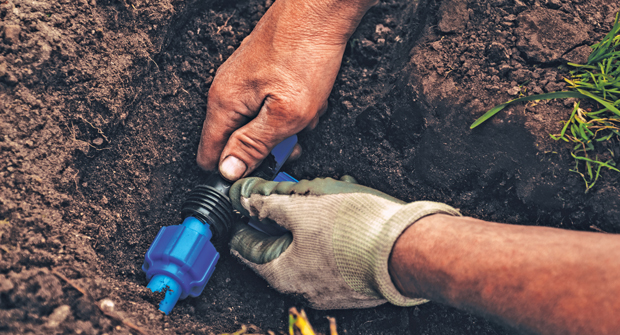Texas A&M researchers seek a simple turfgrass watering formula.
In College Station, Texas, Texas A&M AgriLife Research scientists are trying to utilize evapotranspiration (ET) to help develop simple formulas for watering lawns.
Operating on the principle that history is a good teacher, Charles Fontanier, AgriLife Research associate, and Richard White, Ph.D., AgriLife Research turfgrass physiologist, are conducting studies at the Texas A&M AgriLife Turfgrass Field Lab to determine if historical ET data can be used to predict water needs when irrigating St. Augustine grass.
The goal is to create a message that’s easy to understand for both homeowners and landscape contractors and also will promote water conservation and healthy turf, Fontanier says.
“From the reference ET, we can adjust it to the different types of grasses we are growing, as well as perhaps a microclimate—if it is a sunny spot or a shady spot,” Fontanier says. “So we can adjust the number accordingly. If the number for a warm-season turfgrass in Texas is 0.6, then 60 percent of the weather station output is what we should be applying to our grasses.
“But keeping up with real-time ET data can be too time consuming,” he says. “So our goal for this study was to demonstrate and quantify the effects of using historical average water needs as a predictor of actual plant water needs.”
Fontanier and White have used historical averages to set the irrigation system run times each of the last two growing seasons. For example, on average over the past 47 years, St. Augustine grass has needed about 4.25 inches of water in July. They have used that number to irrigate the grass each July.
Their four treatments in the study were: reference ET from the weather station or 100 percent, which would be an over-watering scenario; turf coefficient, which is what’s theorized that the turfgrass actually needs; and two deficits, 40 percent and 60 percent of the turf coefficient.
“Looking at the two years we’ve had recently and comparing the differences, in 2011 when we really had severe conditions, our main goal with any irrigation was really just bud and crown survival,” Fontanier says. “If we kept enough plants alive, we could get regrowth once rains did come. In fact, that is what we found. Even though we lost a tremendous amount of density in our deficit irrig
ation treatments, the grass survived, and by March, we had close to 100 percent stands.”
Superficially, all the plots looked the same, he says. That’s the important message for areas that can tolerate that seasonal reduction in quality—that St. Augustine grass will survive “if you just moderate your irrigation and keep it moist enough that we have enough buds to stimulate regrowth,” Fontanier says.
FERTILIZER IS KEY TO RECOVERY
A second aspect determined from the study is that nitrogen fertilizer is key to the speed of that recovery, Fontanier says, and the high fertilizer experiments show greater recovery.
“If you look at 2012, where we did get occasional rains, our water conservation treatments or deficit irrigation treatments not only survived, they actually look pretty good,” he says, adding the researchers under-irrigated in 2011 by about 20 percent and over irrigated in 2012 by about 10 percent.
“But if you look at the long haul,” Fontanier continues, “we think we will be right on the money—or at least promoting some level of conservation utilizing historical ET as a base for irrigation.”
Reprinted with permission from Texas A&M’s AgriLife Today, where the author, Ledbetter, is a writer.

